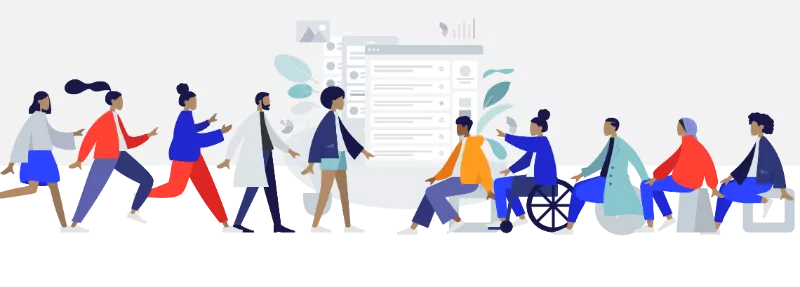Gamification in adult learning: expectations vs reality

Gamification Designer Oliver Šimko shares his experience in making adult learning more engaging through gamification and offers useful tips for anyone interested in designing gamified trainings.
When I studied adult education back in my university days, I thought that because my learners would be adults, the whole learning process would be much more effective in comparison to pupils and teenagers. I (falsely) assumed that most of the adult learners would be internally driven individuals who understood the importance of self-development, and were motivated to cooperate with me and my content.
Facing the reality
Stepping into the practice of teaching, I understood that the reality was quite different. Engaging adult learners can be quite challenging especially when the conditions are not right (ask anyone who has led corporate trainings).
That’s how, my quest to bring engagement to adult education trainings began. And what better place to find techniques for creating engagement than inside an industry whose only purpose is to create engagement – the gaming industry.
Games are fascinating. They are tremendously complicated systems, in which we have to process and learn many things often at same time (have you thought about how much information you process in a simple game like Monopoly?). But since they are extremely well designed, we don't feel overwhelmed by them, and we even consider them fun. If we take a closer look at how players behave, we’ll find that they are acting exactly how we wish our learners would act – they are focused, engaged, entertained and willing to step out of their comfort zone.
It's not surprising that many professionals from various fields spotted this potential and a new field emerged; a field that seeks to apply certain principles, techniques and elements from game design in order to make learning more digestible, engaging and eventually – more effective. This field is called Gamification and since its introduction to the world, it redefined how we design apps, public spaces and, of course, adult education.
From a designer’s point of view, this all makes sense. However, how does it stand out for the adult learners’ point of view?
How adults perceive gamification in learning
Despite the initial enthusiasm, as an industry, we've learned that gamification has its specifics and limitations that we need to be aware of. Not everyone is willing to play and not all of the learners are eager to change their learning routines.
From my experience, these are the three common obstacles that we need to be aware of when thinking and designing gamified trainings.
‘I came to learn, not to play a game’
For adults, training is often considered a serious activity in which they are investing their time and attention. Therefore, anything that does not look serious enough can be suspicious. I agree that a certain sense of authority and credibility has to be conveyed. And for many, this is still done through visuals like PowerPoint. Show something that is obviously a game, and prepare yourself for backlash. The problem is that too often gamified solutions prefer game aesthetics to game design, which includes light-hearted communication and sometimes silly visuals that can undermine your work. Therefore, don't spoil your work with unnecessary game-like visuals if you can effectively deliver your message without them.
Tip: Gamification consists primarily of techniques with background in behavioural science and psychology. It uses timely applied nudges, rich feedback and poses achievable goals that allow you to feel mastery, increasing your status and sense of control. Focus mainly on those principles and be careful when using game-like aesthetics when you deal with more conservative learners.
‘I'm sorry, but why are we playing this game? I don't get it…’
Too many distractions can lead to frustration. It is enticing to turn a training into a full-blown game; and it is true that stories and metaphors are powerful tools. But keep in mind that using overcomplicated game design can overshadow the true message of your training. If you turn your safety training into a survival game – that’s great, but make sure that the message is clear and it reaches the players. When you have to spent significant time explaining the game rules, you can quickly lose your learners’ interest; they can't experience the learning effects of the game yet – what they see is an unnecessary complication in their training.
Tip: Make sure that you make rules as clear as possible. Introduce more complexity as the players progress in the game. Additionally, make sure that you state the purpose of gamification and its anticipated effects before the explanation of the rules. Players have to understand the benefits of the game before they start digesting the rules of the game.
‘I guess it would be more fun if we could play it again’
This one is tricky. Chances are that your players will interact with your gamification for a short period and only once. And this requires a slightly different approach to game design. Most games are created with the assumption that they will be replayed multiple times (or the players will spend many hours mastering them) and often playing a game for the first time does not bring the player an optimal experience (did you enjoy your very first game of chess? Probably not – too many rules, lots of confusion, etc.). Therefore, you have to make sure that the onboarding to your gamification is fool-proof and that the first experience with the game is enjoyable and positive.
Tip: Try to use as little text as possible; make sure that you avoid any complicated rules and exceptions, and if your game needs to become more complicated, make sure that the players receive information at the right time.
So what to make of all of this?
Gamification can indeed make the learning experience more engaging and eventually – more effective. It is a powerful toolbox that can help you improve your trainings. But as with any toolbox, you must first know what you are building and for whom, so you can pick the right tools. And since adult learners are such a diverse group, it's important to know their specifics, challenges, and design the learning experience according to their needs. I hope that sharing these three principles makes your gamified adventure easier.

Oliver Šimko is a founder and lead gamification designer at Luducrafts studio, based in Slovakia. Since 2014, he has designed dozens of gamified experiences, often in the field of adult education. His mission is to make engaged learners the new normal in education.





Comments
What you see is not always what matters
My impression is that gamification was (maybe still is) such trendy some years ago that in many projects people forgot that points, achievements, levels are not enough to make gamification - there must be a good game behind. Even if you have a "gamification" e-learning platform it does not mean that you have a game.
Most of us (educators) where so excited about idea of delivering game that it was easy to forget about such things like purpose, relevance, good playability etc. It was like your first PowerPoint animation - used just after you learned how to do it, probably not really necessary, but you were so proud...
Now - after the first hype - it seems that both suppliers and customers better understand the topic.
I like the point that the first problem is that learners first of all question the purpose of using the gamification.
My approach for training gamification